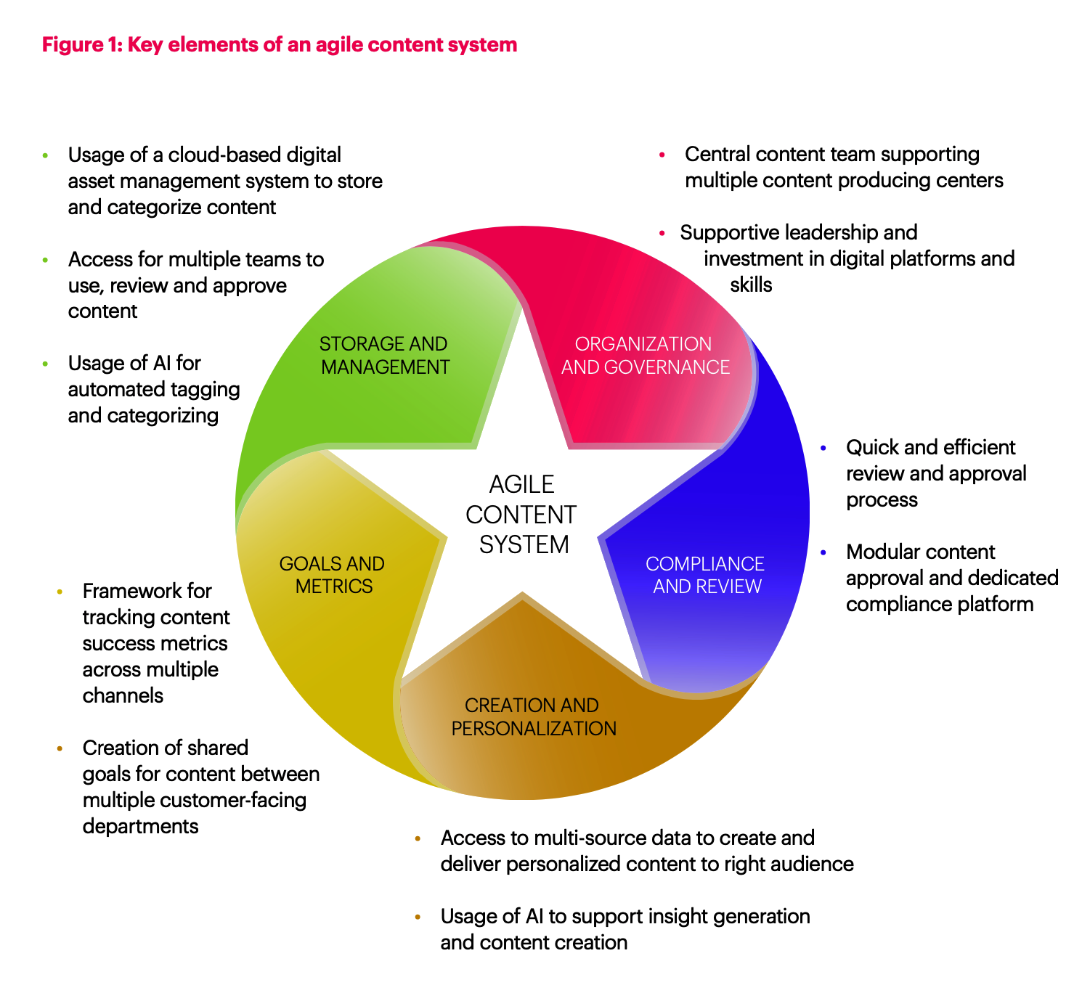The biggest challenge for today’s content producers is to consistently produce personalized content at a large scale, and to credibly impact revenue. Put simply, businesses need to find a way to produce the right content for the right person at the right time and in the right channel. The way most companies are set up today makes this a particularly difficult task, one that can’t be tackled by simply adding more employees or investing more money. Our research shows that the teams who are successful in this endeavor have invested in an innovative set of practices that make up an “Agile Content System”. Here are the five most important ones.

Using data to inform content creation
While most content teams have been using some form of analog data (e.g. surveys, demographic studies) to create content, accessing the right kind of digital data is what sets the innovative teams apart from the rest. Modern content teams should be able to readily see which content is performing best on each digital channel and adjust creative elements accordingly. Additionally, these teams should also be able to access multi-source customer data to help create content that is tailored specifically to unique audience segments.
This kind of repeatable access to data and analytics means investing in platforms that integrate with each other, educating the creative team on how to use data, and most crucially, organizing groups to collaborate in a more efficient way. Additionally, the most sophisticated teams are using the power of AI to generate both insights and content variations based on those insights.
Producing content in modules for approval and recombination
There’s a lot of value in breaking up your content into smaller chunks or modules when you’re creating it. For one, it makes it easier to send and receive compliance or legal approval on smaller chunks of content. It also facilitates more personalization since you can take all those different content modules and recombine them in a variety of ways for different audience segments. Modern AI-powered content systems are now creating a huge number of variations on the same video ad, blog post, or article by automatically recombining different content modules for new end versions.
Centralizing and automating content storage
Digital Asset Management platforms or DAMs have become the best place to store creative content. With cloud storage and easy processes for sharing content drafts for collaboration and approval, DAMs make it much easier to produce more quality content and have it serve a variety of functions across the organization. The key to successfully using a DAM is to have it be the central repository for storing and managing content for all content stakeholders, which may include product, sales, marketing, and service teams. It also follows that there needs to be a standardized tagging and naming scheme that allows multiple teams to upload and download content efficiently. Again, this is another process that can be greatly enhanced with the use of AI that can automatically scan content, determine its themes, and automatically tag/store it in the right location for future use.
Uploading a standard design system
Scaling content means allowing content to be produced in multiple centers, rather than a single group at the center. With so many content-producing groups, it can be difficult to maintain standards in quality, as well as consistency in brand and messaging. Implementing a design system, a process or set of rules that ensure a level of consistency, can help solve that problem and ensure that any new team members or content producers can create and match previously-produced content quality much faster. While most companies have some set of guidelines and rules for brand consistency and visual elements, the most sophisticated ones have evolved this to a “design system” that is embedded in all the content platforms. This enables creators to access the rules and criteria in real time and, in some cases, have the approved visual elements and copy supplied in real time.
Measuring content effectiveness beyond awareness and engagement
While almost every company tries to measure the success of its content in terms of views and clicks (awareness and engagements), the really innovative ones have found a way to attribute even more value to the content by tracking how much revenue it generates, how many customers it moves along the funnel, or how much money it saves by replacing service inquiries. This elevates content to a strategic tool used by all teams and functions rather than a promotional asset used only by the marketers.
Learn more at the upcoming webinar
In the upcoming webinar, Digital Disruption Part 1: Crafting An Agile Content System on Thursday, July 22 @ Noon (Pacific), we’ll explore key trends based on primary research and real-world examples of how others are adopting their techniques and technology for producing, designing, and publishing content for more channels that reach customers than ever before.
Omar Akhtar, Research Director at Altimeter, and David Novak, Senior Partner at Prophet, will share the results from their annual State of Digital Content study, a global benchmark survey that records the latest trends, shifts, practices, and challenges in delivering content to meet the needs of more personalized interactions.
At the end of the event, we’ll send you the presentation and full report so you can dig in further on your own.



Comments are closed.